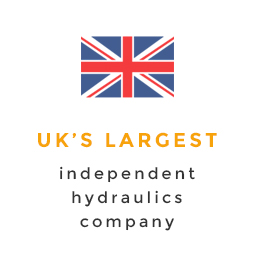World War 1: Hydraulics
Hydraulic systems were used for many applications during World War I, from powering machine tools to operating mining machinery. A hydraulic system has a number of benefits, making it an efficient means of transmitting power - its role in the war effort was undoubtedly vital.
Offering ease and accuracy of control by using levers and push buttons to operate functions such as starting, stopping, speeding up and slowing down the machinery, hydraulic fluid power systems can multiply the force by up to several hundred tons of output.
In addition, it provides a constant torque or force, even if there are speed changes, while it's safe and economical to use, as hydraulic systems have less moving parts than mechanical and electrical systems. This means they're easier to maintain in general.
Read on to find out more about the different uses of hydraulics during the First World War...
Aircraft
World War I marked the first large scale military outing for aircraft. The British Royal Flying Corps expanded, using planes for a number of purposes.
The planes at this time could carry only a small bomb, but there were many fighter pilots who became known as "aces" as a result of their aerial victories against enemy forces.
In 1915, aircraft manufacturer Anthony Fokker developed the French invention of firing machine guns through the plane's propeller. This was the beginning of aerial warfare and the fighter plane was born. By the end of the First World War, around 1,800 pilots were recognised as "aces".
The aircraft were also used by the Allies for dropping propaganda leaflets from 1915 to 1918 in France, Italy and Belgium, while also dispersing demoralising propaganda leaflets amongst German troops.
In addition, planes were used for aerial reconnaissance and war photography. The pilot and passenger, acting as an observer, would embark on tracking missions that commonly involved bombing enemy supply bases and taking photographs to document the mission and influence future strategies.
The use of aerial photography replaced the tethered hot air balloons previously used for surveillance, as these were in constant danger of being shot down, floating only one mile above ground.
While initially there had been resistance to using aircraft during the First World War, due to it being a new technology, all parties soon realised the significance aircraft would play in the war. The design of British aircraft reached new heights and a total of 69 types of plane were in production.
These included the Air Co DH10 Amiens, a twin-engine medium biplane bomber aircraft, which arrived late in the war in 1918. It could fly at 130mph and had a range of 783 miles. It could climb at a rate of 910ft per minute and could fly at a height of 19,029ft.
The Bristol F2 was a multi-use fighter, armed reconnaissance and light bomber aircraft manufactured in 1917. It was successfully adapted from its initial design as a two-seat plane into a single-seat fighter and was armed with a 7.7mm Vickers synchronised machine gun and one or two Lewis machine guns in the rear cockpit.
The use of hydraulic systems was revolutionary at the time, with the new hydraulic-link "CC" synchronising gear being used to operate the Vickers machine gun. The gun would be mounted on the left dorsal surface of the fuselage, with spare magazines stored in any free space in the cockpit.
Across the Channel, the famous Bleriot XI aircraft, manufactured in France by Louis Bleriot since 1909, was commissioned as a training plane in the early stages of the war – it was also used for reconnaissance purposes.
Tanks
The world's first tank, the Mark I, was developed by the British in 1915. Tracked and armoured, it was designed to enter combat.
Developed by the Landship Committee, the first experimental tank was designed by Lieutenant Walter Wilson of the British Royal Naval Air Service, and William Tritton, who was an expert in agricultural machinery.
The Landship Committee became the Tank Supply Committee and the first order for tanks for use in the conflict was placed on 12th February 1916.
Future Prime Minister Winston Churchill, an MP at the time, took up the idea of tanks with enthusiasm and his backing is widely credited with their introduction as a wartime vehicle.
The tank has a hydraulic drive system and it also uses hydraulics to swing the turret and the cannon. When the tanks first came into use, they had multiple guns, each with only a small angle of fire. The early tanks had several turrets, so they could hit targets from any direction.
However, the design was improved to equip it with a 360-degree angle of fire, which was far more efficient than having multiple guns. Using a hydraulic crank, the turret could be turned to any angle, and be raised and lowered with ease.
Submarines
The First World War is often called the first "modern" war, with its use of planes, tanks and also submarines. Using submarine warfare was a completely new phenomenon. It was something used by Germany initially to counter the large British fleet of ships and put pressure on supplies.
On 5th September 1914, the British Royal Navy ship, HMS Pathfinder, was sunk by a torpedo fired from a German submarine, killing 250 of the 268 personnel on board. Up until this point, the British military had been sceptical about whether it was possible for a submarine to sink a ship.
In fact, submarines inflicted more damage than surface ships. They were known as U-boats, the British version of the German term, "U-boot", or unterseeboot - literally translated as "undersea boat".
The British military commissioned around 150 submarines during the Great War. When Admiral John Arbuthnot Fisher, an innovator and strategist, became head of the admiralty in 1914, he developed the craft available to the Royal Navy.
He introduced torpedo boat destroyers, Dreadnought-class fast battleships and encouraged the introduction of submarines. The first submarines of the Great War were the "E" class - a design which had begun in 1913. In total, 47 of these submarines were used by Britain during the conflict. Larger submarines were also introduced, including 14 "G" series in 1915 and 17 "K" class in 1916.
Submarines relied heavily on hydraulics, as the hydraulic fluid (a fast-flowing, light lubricating oil) didn't freeze or lose any fluidity, even at very low temperatures. It lubricated the internal moving parts of the hydraulic units and could even be called upon to operate the power supply in the event of an emergency.
Mines and factories
Many factories used hydraulic power systems during the first world war. In Tinsley, a major munitions factory was responsible for creating shells on land rented from Earl Fitzwilliam. The munitions factory was divided across two sites - a forging shop next to Messrs Firth steelworks and a shell-turning plant next to Templeborough steelworks.
Rectangular-shaped steel billets around 15 inches long were supplied by rail to the factory. They were heated until they were white-hot in coal gas furnaces, before being shaped into cylindrical shell blanks in hydraulic presses.
The work was completed in a long, steel-framed shed with a glass roof, with the furnaces and presses being arranged in two rows. This meant the production of shells could be carried out literally across the whole width of the factory.
In Newcastle, the Armstrong-Whitworth munitions works stretched along the banks of the River Tyne. Founded in 1847 by William Armstrong to manufacture hydraulic machinery, the company expanded into armament production and shipbuilding at the start of the war. By 1918, Armstrong-Whitworth employed 78,000 people.
The neighbouring Elswick Works produced munitions, including guns and shells, hydraulic machinery and ships, as the company also owned the Walker Naval shipyard and made aircraft at Newcastle’s Town Moor.
Hydraulics was also used in mining to make the extraction of fuels possible in a safe and efficient manner. Large-scale operations such as mining require hydraulic equipment, not only to remove the earth and extract the minerals, but also to transport the materials from the mining site to the processing plants.
Without the use of hydraulics, many aspects of Britain's war efforts would not have been possible.
Remembrance Sunday
On Sunday 11th November, people across the nation will be remembering the brave men and women who lost their lives in conflict.
Remembrance Sunday pays tribute to people of all nations who have made the ultimate sacrifice in conflicts over the years. Phoenix Hydraulics will be uniting with the rest of the nation to honour the war dead and to make sure their brave sacrifice is never forgotten.
We will remember them.


